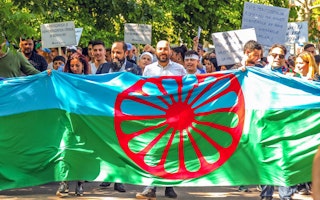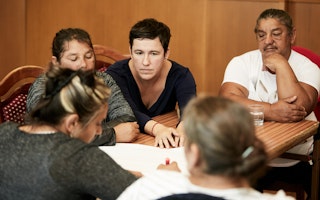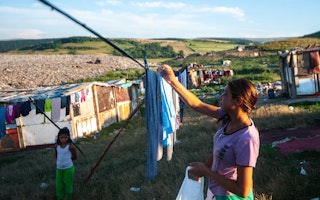Breakfast on the Bus
By Jack Greenberg & Gwendolyn Albert
Not more than a two-hour drive from Budapest’s elegant pedestrian downtown, you wouldn’t really notice that something is out of kilter. The provincial towns have new, bright renovated centers, neat cobbled public areas and are imbued with a cozy neighborliness. Apparently, the post-communist transition is complete and everyone has prosperity and freedom of choice.
Not so.
Travel a little further to the periphery, scratch a little deeper into the social fabric of Hungary, and stop for a moment, and you will soon find the peripheral neighborhoods that would evoke comparisons with the most heartbreaking locations of the Civil Rights era: improvised housing totally inappropriate for a harsh temperate climate, far too many dirty, underfed, and illiterate children, nearly total unemployment for anyone of working age and a deep reliance on what few social benefits suffice to keep a family at or below the poverty line, muddy streets that better resemble a bayou than a public road, and perhaps the best building in the neighborhood, a windswept school, what could be a beacon of stability, progress, and a real future or another marker of segregation and utter despair. But who are these people, hardly any different in appearance from anyone else and avoided like lepers, pushed to the margins, denied services, and treated as subhuman?
Ring any bells?
They are Roma, one of Europe’s most diverse and largest ethnic group estimated to be nearly twelve million strong, people without a state, a parliament, or a clear voice—and a convenient political threat by populist hatemongers in Europe in need of easy political points to hide their own incompetence and mismanagement. Long ignored, far too frequently blamed for every social trauma imaginable, they have been doomed to the margins with no remedy in sight despite a huge philanthropic mobilization and the decisions of Europe’s most authoritative courts.
But take a breath, peep inside the local Roma school and see what you find.
Will it be a heartwarming exception or a broad policy of integration? Mixed rows of Roma and Hungarian children working diligently and attentive, an array of school supplies for each, a teacher and a Roma teaching assistant carefully attending to each child’s needs, helping them surmount the daily obstacles to their education and implant in them the beginnings of the knowledge, perspectives and skills that will allow them to advance equally towards the educational milestones ahead?
Or will it be the chilling status quo, what the Roma have come to expect as typical? A hostile, uncommunicative teacher insisting that her hungry, cold, 100-percent Roma class only fill in the color between the lines, hardly bothering to assign in-class tasks that would require any mental agility from the pupils, much less daring to suggest any homework, the teacher capable of little more than another groan at the thought of another hopeless day diluting the curriculum to make her job simpler?
Naturally, with Hungarian public opinion hardened by a hostile, homogenous domestic media and politics held hostage by revisionist public attitudes towards diversity and modernity, it’s a stalemate between the status quo and the exception: while the state gives lip service to the directives and decisions coming down from the European Union, very little is done, and what’s done is done cautiously with the expected methods of a resistant bureaucracy: decision-making delays, new rounds of studies, more conferences, and ill-willed vacillation on commitments until a new election cycle, when any progress is flushed down the toilet to cater to misconceived majority interests.
Meanwhile, in Hungary’s nearly 1,600 impoverished or marginal Roma settlements scattered around its glorious towns and villages, many local schools doggedly hang on to the old segregation model buttressed by the hollowed out reform vocabulary of decentralization and choice, municipalities repeatedly separating students and classes for fear of earning the electoral ire of the majority—unless forced by the expense of an impending court case or the rare charismatic mayor to change their curriculum and enrollment procedures.
Working in step with a few NGOs to end the worst cases of segregation and inconceivable gaps in Roma children’s education, the Roma Education Fund provides educational programs, incentives, and scholarships to Roma children to attend school and achieve in the classroom. For the youngest and most at risk, these interventions may be morning and midday meals, regular doctor’s visits, basic literacy, and numeracy. For students further in their educational careers, the Roma Education Fund sponsors after-school centers and tutoring tied to academic achievement, and in the most intransigent cases the Fund may even resort to what was the most radical action of the American Civil Rights era with mostly positive implications for generations to come, the decision that catapulted the race and education issue from the TV in the living room to the neat suburban districts nearest you: busing.
But set aside the scenes of hysterical white parents in America in 1971 chaining themselves to school buses ordered to transport their precious white children to black schools. This will never happen in Hungary, such is stigma associated with Roma, and any politician who openly accepts such an option will soon find himself/herself without a job before too long, penalized by an irrational majority explicitly/passively supporting Roma children’s segregation from white schools.
Bus some exceptions have been created by ambitious young mayors, like in the unpronounceable named Hodmezovasarhely or Szeged, where desegregation started right after local elections, Roma-only schools were closed down, school busing is paid by the city, and the Roma Education Fund's mentors are working with the Roma pupils in the afternoons. These actions have been singled out in the best practice catalog of the European Union for a third time and visitors are coming yearly wondering if it is really possible.
Yet, just because you can’t integrate Roma all at once does not mean you should do nothing.
Within the northeastern town of Nyiregyhaza’s municipal limits, two locations host its poorest Roma residents, the Guszev and Keleti settlements, both dispersed far from the town center and isolated from any white neighborhoods or schools. Here, a number of attempts have been made to ensure that the children living in these poor areas are provided with quality education and opportunities for advancement. Over the last four years, a legal campaign by Chance for Children Foundation has forced the local government in Nyiregyhaza to shut down the segregated primary school in this neighborhood and open the doors of Nyiregyhaza’s supposedly off-limits majority schools to Roma pupils.
But how do young children living in a neighborhood untouched by Nyiregyhaza’s public transport services (unlike the majority of white students) get to downtown schools in which they are now suddenly enrolled? What hazards await them on their commute by foot during the few hours of light of eastern Hungary’s notoriously bitter winter? Will any of them show up?
Rather than waiting for a new set of indicators on attendance and achievement for these pupils, the Roma Education Fund, backed by the local Roma community, refused to accept that they were being given access to education (integration) but nothing else other than a mandatory, legislated discount for school-age children on public transport. A solution was negotiated in which the municipality agreed to pay for the driver, fuel, and maintenance, and a grant was cobbled together to purchase to two buses in order to collect pupils each day from Guszev and Keleti, deliver them to their new schools and bring them home each afternoon. Nearly everyone reported better results and seemed to relish the chance to mingle and integrate: Roma children acquired new perspectives and knowledge outside their isolated neighborhoods, Roma parents often accompanied their children on the bus and joined programs to boost their own and their children’s literacy and numeracy and Hungarian-language skills, teachers genuinely welcomed Roma pupils into their classes and schools, and a seemingly receptive majority was glad to see progress, even if the pupils might not have been as well groomed as their classmates and were entitled to breakfast and lunch.
But this cautious cooperation has ceased in the past year due to alleged financial pressures in the municipality and been conveniently matched by a new attempt to reopen Nyiregyhaza’s segregated Roma schools. The buses have been abandoned in a municipal garage and the students from Guszev and Keleti have been left to wind their way to school and back along Nyiregyhaza’s threatening winter roads.
For every bit of progress, two bits of revisionism.
That’s why we fight and that’s why we started.
Jack Greenberg is a board member of the Roma Education Fund.
Gwendolyn Albert is a board member of the Roma Education Fund.


